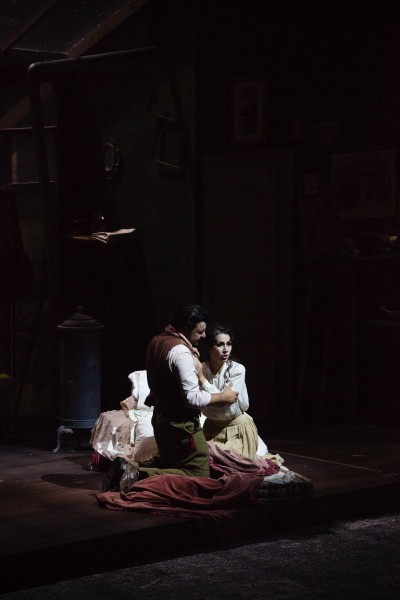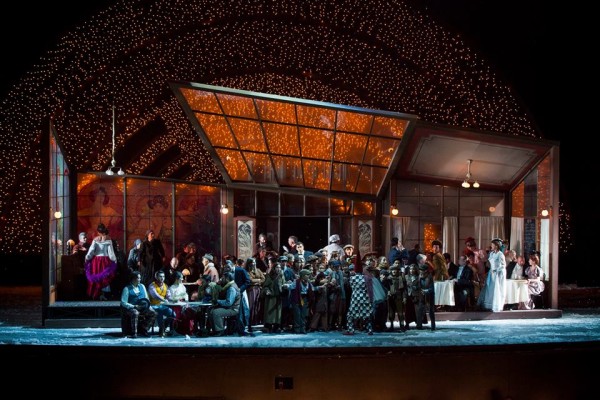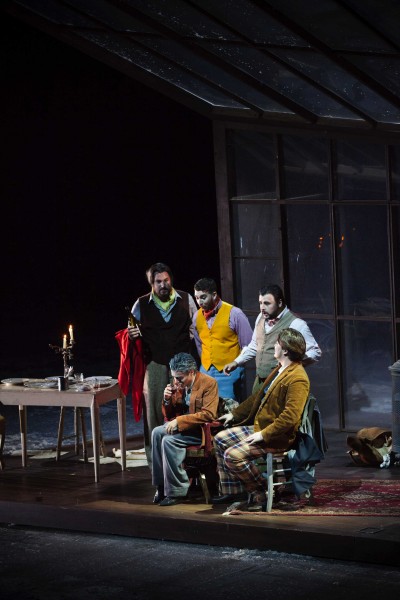La Bohème in Firenze
La Bohème in Firenze
di Giacomo Puccini,
Teatro del Maggio Musicale Fiorentino, 2017 September 14th.
Review by Fabio Bardelli, Fotos: Pietro Paolini – Terra project – Contrasto

La Bohème, Lippi and Mudryak
FIRENZE/ITALY: This performance of La Bohème, second opera of the short “Passione Puccini” cycle at the Teatro del Maggio Musicale Fiorentino in Florence, seems to stand more on the expert shoulders of conductor Francesco Ivan Ciampa than on a cast of young singers.
As it is well known this opera is inspired by Henri Murger‘s novel Scènes de la vie de bohéme, it was composed by Puccini between 1893 and 1895 and premiered in Turin in 1896 under the young Arturo Toscanini
. The librettists Giuseppe Giacosa and Luigi Illica did an important job on Murger’s text, reducing and adapting the French writer’s novel to the stage requirements
. The composer then did the rest, identifying himself as a few other times in his characters’ youth and psychology, whose shows to know from within life and emotions.
More or less at the same time when Puccini was composing La Bohème curiously also another Italian musician Ruggero Leoncavallo was setting in music an opera of the same title derived from the same literary sources. It was premiered in Venice in 1897 but Leoncavallo’s work, which is not contemptible at all, was much less successful than Puccini’s one, whose undisputed achievement all over the world overshadowed Leoncavallo’s opera.
The vocal cast of La Bohème staged now in Florence is young, fresh and fairly homogeneous but without any particular wriggle, scenically credible thanks to the work (exspecially in the first and fourth act) of the director, but about this we’ll speak later.
Nobody in this vocal cast excels, neither for voice nor by interpretation, I dare say that it is a general leveling to a “medium” without high or bottom peak
. But to sing Puccini requires a voice that reveals to the listener a certain timbric fascination or a well-felted interpretation or singers’ strong personality, and this in this performance there wasn’t very much. Also Puccini’s “conversation singing” which also seems so simple needs artistic and vocal personality.
The young soprano Maria Mudryak has a not appealing enough voice, quite suggestive in the “piano” also if sometimes not well sustained but it becomes sour above all when she sings “forte” and mostly in the upper register. She doesn’t sport a great vocal volume and shows some intonation problems, but a certain grace in the singing line that allows her, together with the slender figure on stage (finally a Mimì, notoriously suffering from lung tuberculosis, credibly slim) to delineate a quite suggestive character, albeit with somewhat generic and without particular interpretation flights.

La Bohème, ensemble, 2nd act
Tenor Matteo Lippi is vocally generous, his voice is pleasant (in addition the tenor also shows little fantasy in the phrasing) so the character of the young bohèmien poet comes out quite credibly also scenically.
A bit more interesting in nature is the voice of baritone Benjamin Cho, of good volume and of appreciable colour, he is problably to follow in the coming years.
Angela Nisi as a little thoughtless Musetta, Andrea Vincenzo Bonsignore as Schaunard and Goran Jurić as Colline were on an average level.
Francesco Ivan Ciampa having the experience of a conductor who made his bones in the repertoire conducts with force refinement and theatrical sense orchestra and chorus, both showing excellent performances (the chorus was trained as usual by Lorenzo Fratini). Maestro Ciampa does not show a personal important interpretation or a new one, just accompanying well the singers and getting a good sound from the orchestra, except for a few moments when he overpowers the voices, as well as some excessive slowing and tightening.
Scenically Bruno Ravella’s stage direction isn’t particularly interesting, apart from the cure in making credibly spontaneous and spellfully the bohèmien friends’ acting. The second Act – notoriously very difficult to stage for the quantity of chorists and extras – is really unsuccessful, with the choir or quite motionless as soldiers at the proscenium or walking in Indian row, third Act is almost catatonic (the scene of this act was poor and Franciscan as never before, just a bench, a sentry box, a level crossing bar and some smoke-blowing) with all the singers standing, and so on.
As we said, the scenes by Tiziano Santi were nothing special, aside from an attempt to reduce the great stage of the House in the first second and fourth act with a central lopsided element, which however makes a curious “Nativity little hut” effect.
We can quote the normal costumes by Angela Giulia Toso, modernized but not too much if compared to the period in which the plot should take place according to the libretto, the avoidable honeyed stars in the sky, brilliant little lights and very copious snowfall and an everending one during scene-change between first and second act.
The light design by D. M
. Wood was very accurate and the large audience gave a real success for everyone.

La Bohème. 1st act, the four friends with Benoit
Distribution:
Direttore, Francesco Ivan Ciampa
Regia, Bruno Ravella
Scene, Tiziano Santi
Costumi, Angela Giulia Toso
Luci, D. M. Wood
Maestro del Coro, Lorenzo Fratini
Orchestra, Coro e Coro delle voci bianche del Maggio Musicale Fiorentino
Mimì, Maria Mudryak
Rodolfo, Matteo Lippi
Marcello, Benjamin Cho
Musetta, Angela Nisi
Schaunard, Andrea Vincenzo Bonsignore
Colline, Goran Jurić
Benoît, William Hernandez
Parpignol, Carlo Messeri
Alcindoro, Alessandro Calamai
Sergente dei doganieri, Vito Luciano Roberti
Un doganiere, Nicolò Ayroldi
Venditore ambulante, Leonardo Sgroi
